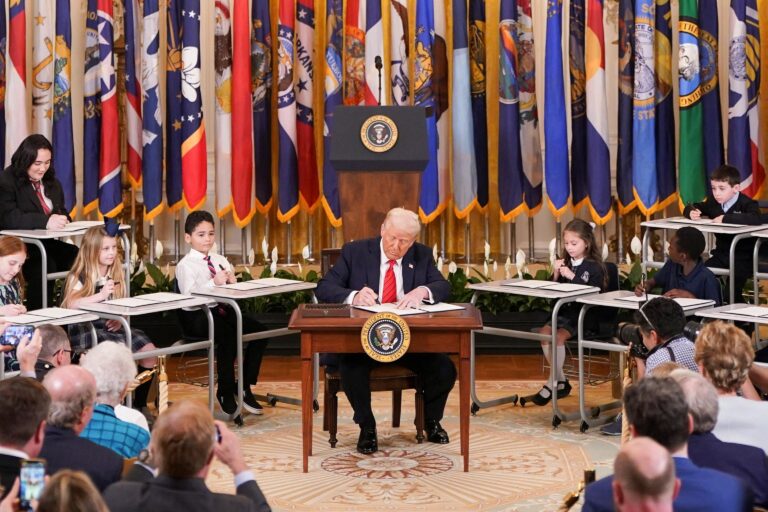Federal Education Department Dismantling: A New Direction in U.S. Education Policy
In a bold and controversial decision, President Donald Trump has enacted an executive order aimed at dissolving the U.S. Department of Education. This directive, unveiled on Monday, initiates a comprehensive overhaul of federal involvement in education, emphasizing a shift toward empowering state and local authorities. The administration asserts that reducing federal control will foster greater autonomy for local education systems. However, this unprecedented move has ignited intense debate among educators, policymakers, and civil rights advocates, who caution about potential risks to funding stability and nationwide educational equity.
Highlights of the executive order include:
- Gradual withdrawal of the Department’s regulatory powers
- Direct allocation of federal education funds to state governments
- Creation of oversight panels to supervise the transition process
- Temporary continuation of select federal programs during the phase-out
| Function of Department | Proposed Reassignment | Expected Transition Period |
|---|---|---|
| Management of Student Loans | Shifted to the Department of Treasury | Within 12 months |
| Enforcement of Title IX | Delegated to State-Level Agencies | Within 6 months |
| Special Education Services | Retained with Limited Federal Oversight | Within 18 months |
Consequences for Public Schools and Federal Funding Mechanisms
The executive order to dismantle the Department of Education has sent ripples through public school systems nationwide, creating uncertainty about the future of federal oversight and financial support. Key programs such as Title I, which provides aid to economically disadvantaged students, and IDEA, which funds special education, face potential disruption. This uncertainty threatens to disproportionately impact vulnerable student populations who depend heavily on federal assistance.
Educators and policymakers have voiced concerns regarding:
- Elimination of centralized federal accountability, which may lead to uneven educational quality across states.
- Possible reductions or delays in federal funding, affecting essential services like school meal programs and classroom materials.
- Inconsistent enforcement of civil rights and educational standards, due to the absence of a unified federal authority.
| Funding Program | Annual Budget | Projected Impact |
|---|---|---|
| Title I Grants | $15 billion | High likelihood of budget cuts |
| IDEA Funding | $12 billion | Uncertain funding distribution |
| National School Lunch Program | $13 billion | Potential delays in disbursement |
Insights from Education Specialists on Student Support and Oversight Challenges
Experts in education policy and advocacy organizations have raised alarms about the potential fallout from dismantling the federal education agency. They emphasize that programs critical to supporting low-income students, special education, and marginalized communities may experience significant interruptions. Concerns include funding gaps, delays in essential services, and diminished oversight, which could disproportionately harm students reliant on federal assistance.
Accountability frameworks that have historically ensured consistent educational standards and equity are also at risk. Analysts warn that weakening data collection and reporting systems could undermine transparency and comparability across school districts. The table below summarizes key expert concerns:
| Impact Area | Possible Outcome | Expert Opinion |
|---|---|---|
| Student Financial Aid | Disruptions in processing grants and loans | “May cause immediate financial hardship for students dependent on federal aid.” |
| Special Education Programs | Weakened oversight of Individualized Education Plans (IEPs) | “Risks leaving vulnerable students without necessary tailored support.” |
| School Accountability | Loss of standardized data collection and reporting | “Threatens transparency and comparability across districts.” |
| Equity Initiatives | Possible deprioritization of underserved groups | “Could exacerbate existing achievement disparities.” |
In light of these challenges, education leaders advocate for comprehensive contingency plans and interim governance frameworks to safeguard the continuity of vital student services. Without strategic management, the academic progress and well-being of many students could suffer long-term consequences.
Strategic Recommendations for State and Local Education Authorities Amid Transition
State and local education bodies must rapidly adjust to the evolving educational landscape following the executive order. Embracing greater self-governance is crucial to compensate for the federal department’s phase-out. Strengthening collaboration among school districts to exchange resources, expertise, and support will be vital. Recommended approaches include:
- Empowering local leadership: Enable school boards and administrators to tailor policies that meet unique community needs without federal constraints.
- Enhancing educator training: Expand professional development programs to maintain high educational standards independently.
- Improving digital infrastructure: Address disparities in technology access to ensure equitable learning opportunities as federal oversight wanes.
Financial stewardship will be a significant hurdle as federal funding structures dissolve. Agencies should prioritize transparent and innovative budget realignment to optimize state and local resources. The following table outlines critical focus areas and actionable steps for education leaders:
| Focus Area | Short-Term Action | Long-Term Objective |
|---|---|---|
| Accountability Frameworks | Develop independent evaluation metrics | Ensure consistent education quality without federal oversight |
| Budget Management | Reassess and prioritize spending | Achieve sustainable funding through local and state sources |
| Curriculum Design | Formulate community-specific standards | Reflect local values and educational priorities |
Conclusion: Navigating the Future of U.S. Education Post-Dismantling
As the nation begins to experience the ramifications of President Trump’s executive order to dissolve the Department of Education, stakeholders remain vigilant about the evolving federal role in education policy and funding. This landmark decision represents a pivotal shift toward decentralization, sparking widespread discussion about the future of public education and oversight mechanisms. In the weeks ahead, responses from Congress, state governments, and education advocates will be critical in shaping how the country adapts to this transformative change.







